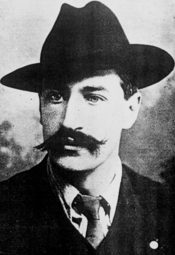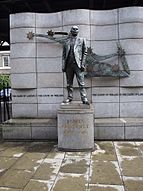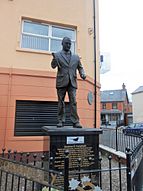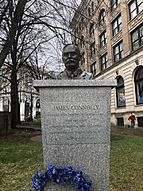James Connolly facts for kids
Quick facts for kids
James Connolly
|
|
|---|---|
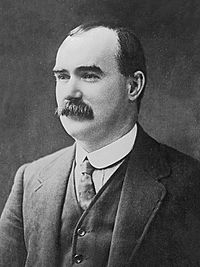 |
|
| Born | 5 June 1868 Cowgate, Edinburgh, Scotland
|
| Died | 12 May 1916 (aged 47) Kilmainham Gaol, Dublin, Ireland
|
| Political party |
|
| Spouse(s) |
Lillie Connolly
(m. 1890) |
| Children | 7, including Nora and Roddy |
| Military service | |
| Buried |
Arbour Hill Prison, Dublin
|
| Service/ |
|
| Years of service |
|
| Rank | Commandant General |
| Unit |
|
| Battles/wars | Easter Rising |
James Connolly (Irish: Séamas Ó Conghaile; 5 June 1868 – 12 May 1916) was an important Irish republican, socialist, and trade union leader. He was born in Edinburgh, Scotland, to Irish parents. James left school at age 11 to start working. In the 1880s, he became involved in socialist politics.
Connolly is best known for his work in Irish politics. But he also played a role in Scottish and American politics. He was a member of the Industrial Workers of the World. He also founded the Irish Socialist Republican Party. With James Larkin, he helped lead the Dublin lock-out in 1913. After this, they formed the Irish Citizen Army (ICA). They also started the Irish Labour Party with William O'Brien. Connolly was a key leader in the Irish Transport and General Workers' Union (ITGWU). He took over leadership of the union and the ICA when Larkin went to the United States. He led both until his death.
He was against British rule in Ireland. He was one of the leaders of the Easter Rising in 1916. During the Rising, he commanded the Irish Citizen Army. After the Rising failed, he was arrested. He was taken to Kilmainham Gaol and executed by firing squad.
Contents
Early Life of James Connolly
Connolly was born in a poor area of Edinburgh in 1868. He was the third son of John Connolly and Mary McGinn. His parents had moved to Scotland from County Monaghan, Ireland. They lived in the Cowgate area, where many Irish people settled. James spoke with a Scottish accent his whole life.
He was born in St Patrick's Roman Catholic parish. This area of Edinburgh was known as "Little Ireland." His father and grandfathers were labourers. James went to a local Catholic primary school until he was about ten. After that, he worked in different labouring jobs. Because of money problems, he joined the British Army, like his older brother John.
He joined the army when he was 14. He lied about his age and used the name Reid. He served in Ireland for almost seven years. This was a time of trouble in rural areas, known as the Land War. He later became involved in land issues himself. He grew to dislike the British Army very much. When he heard his group was moving to India, he left the army.
Connolly had another reason to stay in Scotland: Lillie Reynolds. She was his future wife. Lillie moved to Scotland with James after he left the army. They got married in April 1890 and settled in Edinburgh. There, Connolly joined the Scottish Socialist Federation. In 1895, Connolly tried to open a shoe repair shop. It failed quickly because he wasn't very good at fixing shoes. He became more focused on the socialist movement instead.
James Connolly's Socialist Work
In the 1880s, Connolly was influenced by Friedrich Engels and Karl Marx. He later supported a type of socialism based on Marxist ideas. Connolly called himself a socialist. He is also known for helping to start Christian socialism in Ireland.
He became the secretary of the Scottish Socialist Federation. His brother John was the secretary before him. John lost his job after speaking at a rally for an eight-hour day. So, James took over as secretary while John looked for work. During this time, Connolly also joined the Independent Labour Party. This party was formed by Keir Hardie in 1893. He also learned and promoted Esperanto, an international language. He wrote a short story called The Agitator’s Wife. His interest in Esperanto is clear in his 1898 article "The Language Movement." This article tried to connect socialism with Irish nationalist ideas.
By 1893, he was active in the Scottish Socialist Federation. He became its secretary in 1895. Two months after his third daughter was born, Connolly heard about a job in Dublin. The Dublin Socialist Club needed a full-time secretary, offering a pound a week. Connolly and his family moved to Dublin, and he took the job. He helped the club quickly become the Irish Socialist Republican Party (ISRP).
While working as a socialist in Britain, Connolly started a newspaper called The Socialist. He also helped found the Socialist Labour Party. This party split from the Social Democratic Federation in 1903. Connolly joined Maud Gonne and Arthur Griffith in Dublin protests. These protests were against the Boer War.
Time in America
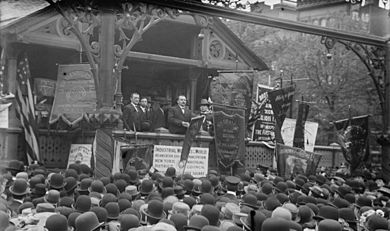
Connolly was frustrated with the slow progress of the ISRP. He also needed money. So, in September 1903, he moved to the United States. He didn't have a clear plan for what he would do there. In America, he joined several groups. These included the Socialist Labor Party of America (1906) and the Socialist Party of America (1909). He also joined the Industrial Workers of the World. In 1907, he founded the Irish Socialist Federation in New York. He became the editor of the Free Press, a socialist newspaper. This paper was published in New Castle, Pennsylvania, from 1908 to 1913. In his 1910 book Labour in Irish History, he wrote a chapter called "A chapter of horrors." This chapter criticized Daniel O’Connell for not helping the working class.
Return to Ireland
When Connolly returned to Ireland in 1910, he worked closely with James Larkin. Larkin was a leader in the Irish Transport and General Workers Union. Connolly tried twice to be elected to the Dublin Corporation. He was not successful. The 1911 Census of Ireland lists his job as "National Organiser Socialist Party." In 1911, Connolly wrote about King George V's visit to Ireland. He argued that public ownership should replace capitalist ownership. He believed social democracy should replace inequality. He said the power of workers should destroy the power of birth and capitalism.
1913 Dublin Lock-out and New Groups
In 1913, the Dublin lock-out happened. This was a major strike. In response, Connolly, James Larkin, and Jack White formed the Irish Citizen Army (ICA). This was an armed group of workers. Their goal was to protect workers and strikers. They especially wanted to protect them from the Dublin Metropolitan Police. The ICA had about 250 members. Their main goal soon became creating an independent and socialist Irish nation.
With Larkin and William O'Brien, Connolly also founded the Irish Labour Party. This was the political side of the Irish Trades Union Congress in 1912. Connolly was also an editor for The Irish Worker. This newspaper was shut down during World War I. Around this time, he met Winifred Carney in Belfast. She became his secretary and later joined him in the Easter Rising. Like Vladimir Lenin, Connolly was against the First World War. He said, "I know of no foreign enemy of this country except the British Government."
Easter Rising Role
Connolly and the ICA planned an armed uprising during World War I. They made these plans separately from the Irish Volunteers. In early 1916, Connolly thought the Irish Volunteers were taking too long. He threatened to send the ICA to fight the British Empire alone. This worried the Irish Republican Brotherhood (IRB). The IRB had already joined the Volunteers and planned their own uprising that year.
To stop Connolly from acting alone, IRB leaders met with him. These leaders included Tom Clarke and Patrick Pearse. They wanted to reach an agreement. During the meeting, the IRB and the ICA agreed to work together. They decided to act during Easter of that year.
The Easter Rising began on 24 April 1916. Connolly was the Commandant of the Dublin Brigade. The Dublin Brigade played the biggest role in the Rising. So, Connolly was the main commander. Connolly's leadership during the Easter Rising was very strong. Michael Collins said he "would have followed him through hell." After they surrendered, Connolly told other prisoners: "Don't worry. Those of us that signed the proclamation will be shot. But the rest of you will be set free."
James Connolly's Death
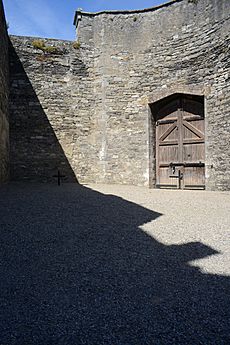
Connolly was not held in a regular prison cell. He was in a room at the State Apartments in Dublin Castle. This room is now called the "Connolly Room." It had been turned into a first-aid station for soldiers.
Connolly was sentenced to death by firing squad for his part in the Rising. On 12 May 1916, he was taken by military ambulance to Royal Hospital Kilmainham. From there, he was taken to Kilmainham Gaol for his execution. While in the hospital, his wife and daughter visited him. He told them: "The Socialists will not understand why I am here; they forget I am an Irishman."
Connolly was badly injured from the fighting. A doctor said he had only a day or two to live. But the order for his execution was still given. He could not stand before the firing squad. He was carried to a prison courtyard on a stretcher. A priest, Father Aloysius Travers, gave him his last prayers. When asked to pray for the soldiers who would shoot him, he said: "I will say a prayer for all men who do their duty according to their lights." He was tied to a chair and then shot. He was not marched to the usual execution spot.
His body, along with other leaders, was put in a mass grave. There was no coffin. The executions of the rebel leaders made most Irish people very angry. Before this, most people had not supported the rebellion. Connolly's execution caused the most anger. Historians say the way Connolly and others were executed helped people understand their goals. This gained support for the movements they died fighting for.
The executions were not popular, even in Britain. They also drew unwanted attention from the United States. The British government wanted the U.S. to join the war in Europe. H. H. Asquith, the Prime Minister, ordered no more executions. The only exception was Roger Casement, who was charged with treason. Although he had stopped practicing religion in the 1890s, Connolly returned to Roman Catholicism before his execution.
James Connolly's Political Ideas
Syndicalism
Connolly was a socialist, but more specifically, a Syndicalist. Syndicalism is a type of socialism. It believes that socialism will happen through the actions of trade unions. In a socialist society, unions would control how things are made. Connolly's syndicalism grew from his interactions with Daniel DeLeon, the Industrial Workers of the World, and Jim Larkin. Connolly did take part in elections. However, he came to believe that strikes were the best way for workers to gain power. Connolly also supported the idea of workers forming "One Big Union."
Connolly and DeLeon often disagreed. One point was about wage increases. DeLeon thought that any pay raise for workers would be quickly cancelled out by higher prices. Connolly argued that Karl Marx himself disagreed with this idea. Connolly believed that saying wage increases were pointless would stop socialists from fighting for better conditions for workers.
In 1914, Connolly published Labour in Irish History. In this book, he looked at Irish history using Marxist ideas. He argued that before British rule, the Irish lived in a type of stateless communism. The book also criticized Daniel O'Connell. O'Connell worked for Catholic emancipation. But Connolly felt it only helped rich Catholics, not all Catholics.
Connolly imagined the Industrial Workers of the World forming their own political party. This party would unite different socialist groups. He also saw an independent Ireland as a socialist republic. His ideas about revolutionary unionism and Syndicalism have led to debates. People wonder if his vision for a workers' republic was about state control or local control. For a time, he was involved with De Leonism and the Second International. But he later broke away from both.
Religion
Throughout his political life, Connolly believed that religion and socialism could exist together. Although he was an atheist for much of his life. Connolly thought socialists should focus on economic and political issues. He believed they should avoid debating religion, especially with religious leaders. Connolly saw attacking religion as a mistake for socialists. He thought it would get them stuck in unnecessary arguments. He also believed that any religion promoting equality and kindness could help bring about socialism. In 1910, Connolly wrote a pamphlet called Labour, Nationality and Religion. In it, he clearly stated that Socialism and Catholicism were not incompatible.
Nationalism
Historian Fergus D'arcy says that before 1910, Connolly wasn't very focused on nationalism. But living in Ireland made him think about the "national question." In 1911, Connolly had a public debate with Belfast socialist William Walker. Walker argued that socialism in Ireland would only happen if Ireland stayed part of the United Kingdom. He called himself an "Internationalist," not a nationalist. Connolly disagreed. He believed that "the only true socialist internationalism lay in a free federation of free peoples."
Connolly committed himself and the Irish Citizen Army to the Easter Rising. But he was still careful about the Irish nationalists he was working with. A week before the Rising, he reportedly told ICA members: "in the event of victory, hold on to your rifles, as those with whom we are fighting may stop before our goal is reached. We are out for economic as well as political liberty." In Scotland, Connolly's ideas influenced socialists like John Maclean. Maclean also combined his socialist ideas with nationalist ones. He formed the Scottish Workers Republican Party.
Feminism
Connolly cared a lot about the role of women in society. In 1915, he wrote in The Reconquest of Ireland: "The worker is the slave of capitalist society, the female worker is the slave of that slave." He also wrote: "of what use...can be the re-establishment of any form of Irish state if it does not embody the emancipation of womanhood?" Connolly supported the Suffragette movement. Francis Sheehy-Skeffington said Connolly was "the soundest and most thorough-going feminist among all the Irish labour men." Connolly thought that the oppression of women was a result of private property. He believed that men should not liberate women. Instead, women should liberate themselves, with the help of supporting men.
James Connolly's Family Life
James Connolly and his wife Lillie had seven children. Nora grew up to be an important writer and activist. She worked within the Irish-republican movement. Roddy continued his father's political work. Later, both Nora and Roddy became members of the Oireachtas (Irish parliament). Moira became a doctor and married Richard Beech. One of Connolly's daughters, Mona, died in 1904 at age 13. She was burned while doing laundry for an aunt. Three months after James Connolly was executed, his wife Lillie joined the Catholic Church. This happened on 15 August.
James Connolly's Legacy
Connolly's importance in Ireland comes mainly from his role in the republican cause. His socialist ideas have been claimed by many left-wing groups. He is also linked to the Labour Party, which he founded. Connolly was one of the few European members of the Second International who strongly opposed World War I. This put him at odds with most other socialist leaders in Europe. Connolly has been seen as a "political idol" for many trade unionists. These include Mike Quill and Mick Lynch.
Tributes to James Connolly
- In 1928, miners in Follonsby, Durham, created a new banner. It included a picture of Connolly. The banner was burned in 1938. A new one was made but painted over in 1940. A copy of the 1938 Connolly banner was made in 2011. It is often shown at events in County Durham and other places.
- Connolly Books is a leftist bookstore in Dublin. It was started in 1932 and is named after Connolly.
- The Connolly Association is a British group formed in 1938. It works for Irish unity and independence. It is also named after Connolly.
- Connolly and his death are mentioned in the song "The Patriot Game" by Dominic Behan. This song was released in 1958.
- In 1968, the Irish group The Wolfe Tones released a song called "James Connolly." It reached number 15 on the Irish charts. The band Black 47 also wrote a song about Connolly. Irish singer-songwriter Niall Connolly has a song "May 12th, 1916 – A Song for James Connolly." "Connolly Was There" is a popular Irish folk song. It celebrates Connolly's work for unions in Ireland. Derek Warfield sang a well-known version.
- The Non-Stop Connolly Show (1975) was a 12-hour play. It was about James Connolly's life and politics. John Arden and Margaretta D'Arcy wrote it.
- Dunedin Connollys GFC is a Gaelic Athletic Association (GAA) club in Edinburgh, Scotland. It was founded in 1988 and is named after him.
- The song "James Connolly" is on the 1991 album Black 47 by the band Black 47. It celebrates his work as a socialist and republican.
- In a 2002 BBC TV show, 100 Greatest Britons, Connolly was voted 64th.
Memorials for James Connolly
There is a statue of James Connolly in Dublin. It is outside Liberty Hall, the offices of the SIPTU trade union. Another statue of Connolly is in Union Park, Chicago. It is near the offices of the UE union. There is a bust of Connolly in Troy, New York. It is in the park behind the statue of Uncle Sam. In March 2016, a statue of Connolly was revealed. It is on Falls Road in Belfast. Carál Ní Chuilín and Connolly's great-grandson, James Connolly Heron, were there.
Connolly Station is one of the two main railway stations in Dublin. Connolly Hospital, Blanchardstown is also named in his honor.
See also
 In Spanish: James Connolly para niños
In Spanish: James Connolly para niños
- James Connolly bibliography


